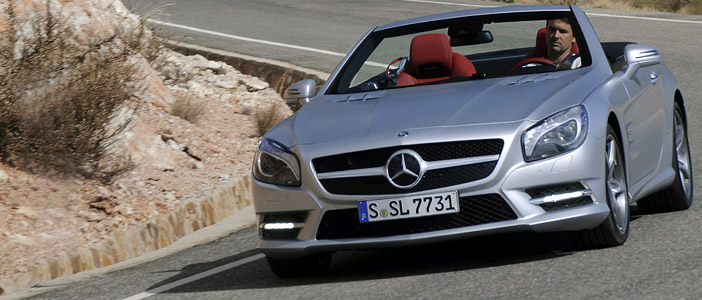First Drive: 2013 Mercedes-Benz SL 500

I’ll lay my cards on the table immediately. Europeans have different driving expectations to Americans, and they don’t get much further part when it comes to the new Mercedes SL. I am not say either group has better claim to getting it right. But with your wide-open spaces and our narrow roads and closely packed cities, the automotive requirements are simply different. Can you think of a good reason to drive a Smart ForTwo? Thought not, but plenty of Europeans can.
So when the guys at Mercedes, to a man, call the new SL their ‘sports car’ we kinda grimace. Sports cars encompass low weight and agility to the European mindset. Cars like a Lotus or Mazda MX-5 hit the nail on the head. The Boxster squeezes in, the 911 is on the extreme margins and Mercedes SL is simply something else altogether.
Yet this new SL has many of the right credentials. It looks simply awesome for starters. Mercedes hasn’t tried to develop the previous design or build a poor man’s version of the SLS. Complex curves, scoops and sharp lines intersect in so many different areas it’s hard to take it all in.
The structure is now all-aluminum, rather than aluminum over a steel frame. Dr Thomas Rudlaff confided to Teamspeed that without the change the SL would get uncomfortably close to 2000 kg (4400 pounds), which would stretch the credibility of that Sport Lightweight nomenclature. Now the SL is around 100kg lighter than before and, with a smaller capacity 4.7-litre V8 fitted with twin turbochargers, power is up 22% to 435hp.
Performance
Stick your foot hard down and the SL settles down at the back end, squirms a bit and lunges forward, to a delightful soundtrack from the engine. It never fails to impress and this will, I suspect, be enough to make the SL 500 the sports car many were dreaming of.
Stick to cruising and the SL is truly in its element. Wafting around with the seven-speed transmission silkily shifting gears, there’s rarely a need to take manual control by using the paddles behind the steering wheel.
There are, naturally, buttons that engage a more sporting gearchange mode, altering the shift pattern and making the pedal more sensitive to movement. Yet this is an issue that is never fully resolved, whatever setting you select. In the manner of Mercedes past, the pedal will move what seems like a couple of inches before there’s a tangible pick up in acceleration, and then the SL will take off all too rapidly.
It’s this behavior that counts against the SL when it comes to making the grade as a proper sports car. Increase the pressure on the accelerator as you leave a corner and you are never quite sure when the power is going to kick in.
The turbo-chargers probably don’t help here. Turbo lag shouldn’t be an issue these days, but there is certainly a step input as the revs rise and the torque really kicks in as the turbos spool up. If you doubt my analysis, well, the first thing the Mercedes engineer asked me was whether the engine was below or above the turbo power band as I left the corner.
The steering is nicely light but provides little in the way of feedback. And then there’s that multiplexing darned computer, controlling so much of the SL’s attitude that driving the Mercedes 500SL is, you can’t help concluding, something that doesn’t need much input from you.
The acronym count – ATTENTION ASSIST, ADAPTIVE BRAKE, yadda, yadda, yadda, all in essential CAPIATL LETTERS, has reached such a level that even Mercedes PR folk have given up and just state there are now sixteen separate systems to keep your SL in line.
Where the SL really works well is on wider, open roads with sweeping curves. The Mercedes takes these in regal elegance and it makes you feel rather good. It’s a valid reason for buyers to choose an SL over a Porsche 911 convertible.
